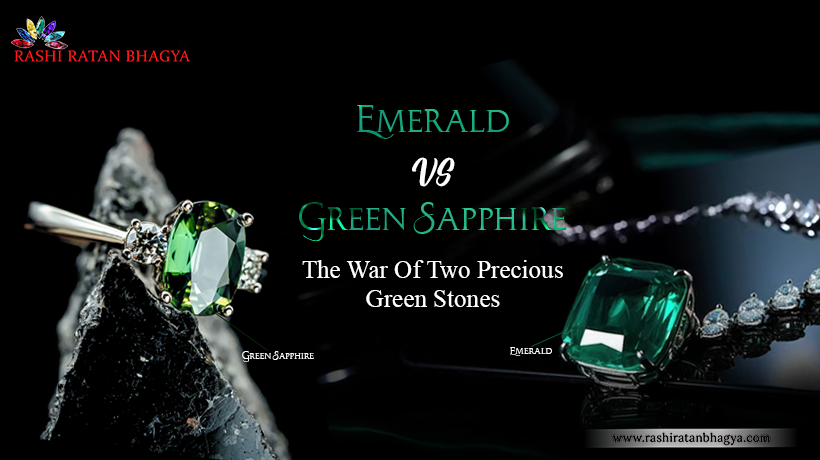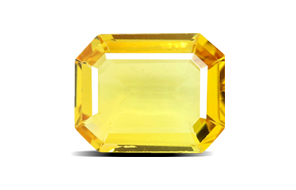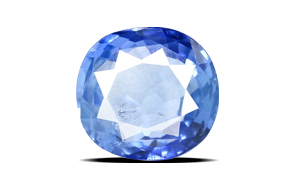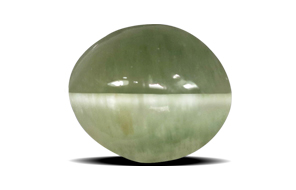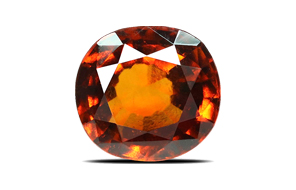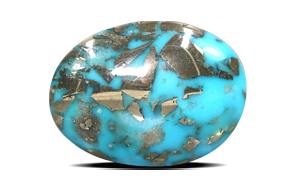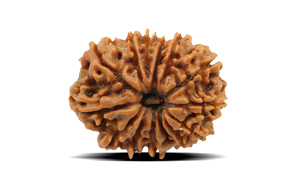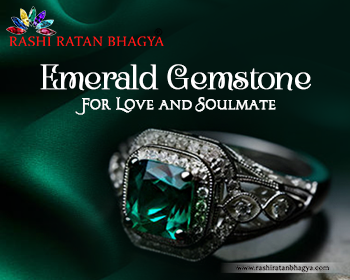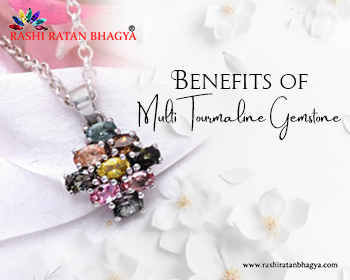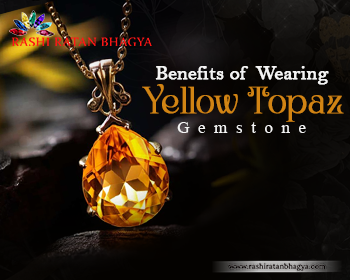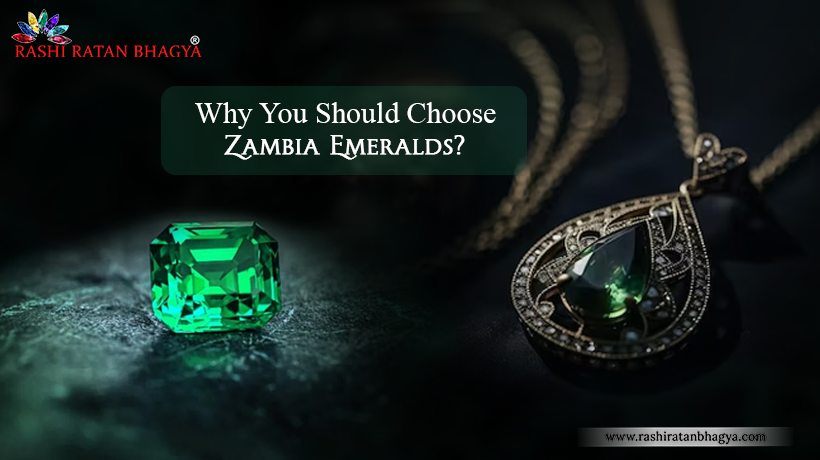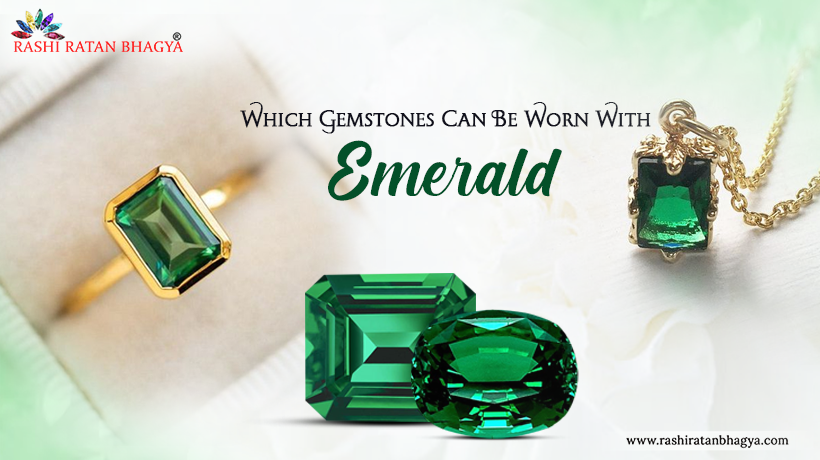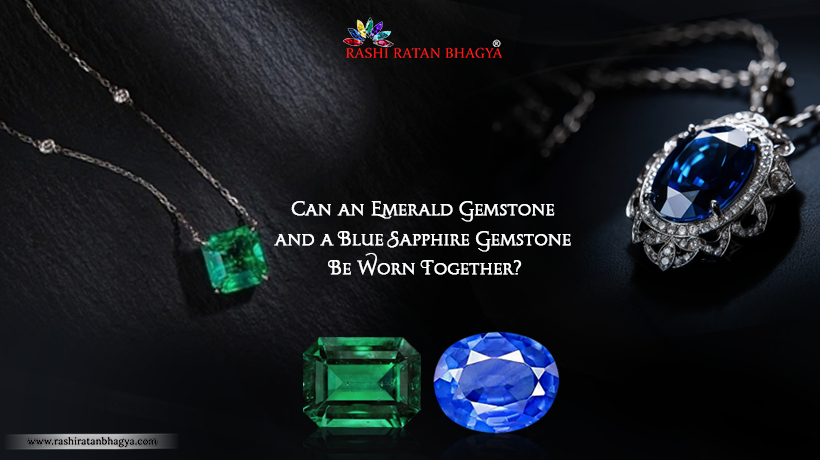Humans have a natural desire to compare the two best or most desirable creatures and crown one as the victor. No domain is immune to such comparisons, and diamonds are no exception. Green gemstones are one of the most appealing gemstone kinds based on color. According to color psychology, green indicates a variety of desirable qualities such as tranquility, vitality, and freshness. As a result, green diamonds are selected mostly by individuals seeking knowledge, vitality, and serenity in life.
Natural Panna stone and green sapphire are the most sought-after and costly gemstones, with distinct properties and transformative astrological advantages. The emerald or panna gemstone belongs to the Beryl mineral family and gets its green color from traces of Vanadium or Chromium. Green Sapphire, on the other hand, is a member of the Corundum mineral family (which is composed of aluminum oxide) and gets its green hue from iron traces. Though these jewels have rich green to light green tones with dull yellow colors, they differ significantly.
This blog entry on Emerald versus Green Sapphire provides the most detailed and technical comparison of these gigantic gemstones based on origin, color, hardness, physical features, astrological advantages, pricing, and popularity.
The Comparison Of Two Precious Green Gemstones: Emerald Vs Green Sapphire
The Comparison Between these 2 precious Green Gemstones is due to these factors. Here we can compare both gemstones one by one by the factors.
- Color
- Origin
- Hardness
- Physical Properties
- Price & Popularity
- Astrological Benefits Of Green Gemstones
1). Green Sapphire vs Emerald: Color
Green Sapphire:
Color Range: Green sapphires may have a variety of green tones, from light to dark. The hue might range from yellowish-green to bluish-green.
Green sapphires can have a broad range of tones, from lighter to darker than emeralds. Some green sapphires may seem pastel-like, while others may be more vibrant and vivid.
Sapphires, even green sapphires, can include inclusions, however, they are more commonly tolerated in sapphires than in emeralds. Sapphires are noted for their toughness and are less likely to break than emeralds.
Emerald:
Color Range: Emeralds are generally green gemstones made from the mineral beryl. The most ideal emerald color ranges from pure green to somewhat bluish-green, with intense saturation.
Tone: Emeralds often have a medium to medium-dark tone, meaning they are neither too light nor too dark. This permits the green hue to be vibrant.
Inclusions: Natural emeralds frequently feature inclusions known as "jardin" (French for garden). These inclusions are normal in emeralds and can be viewed as part of their character.
2). Green Sapphire vs Emerald: Origin
Green Sapphires
Green Sapphire Gemstones occur naturally in metamorphic rock, volcanic rock, and certain sediments. They are also present in alluvial sediments.
Thailand, Australia, Nigeria, Tanzania, China, Madagascar, Montana in the United States, and Pailin in Cambodia are among the countries that have contributed. Deposits vary in age.
Iron and titanium are trace elements that interact to create green colors. Most green sapphires include far fewer trace elements than other sapphire hues.
To summarize, emeralds originate in igneous and metamorphic hydrothermal veins and greisen. Green sapphires develop in a variety of rock types and places.
Emeralds
Natural emeralds occur naturally in igneous and metamorphic rocks. Some frequent sources are hydrothermal veins and greisen deposits.
Typically found in nations such as Colombia, Brazil, Zambia, Afghanistan, Russia, Egypt, Zimbabwe, Pakistan, and India. Some deposits go back three billion years.
Associated with trace elements such as chromium, vanadium, and beryllium. Chromium is responsible for the green hue.
3). Green Sapphire vs Emerald: Hardness
Green Sapphire
Aluminum oxide (Al2O3) contains traces of iron, titanium, and chromium.
Mohs hardness: nine.
Typically lighter green than emerald.
Emerald
Chemical composition: beryllium aluminum silicate (Be3Al2(SiO3)6)
Mohs hardness range: 7.5-8.
Known for its vivid green hue.
The primary difference in hardness between the original panna stone and green sapphire is that emerald ranks 7.5-8 on the Mohs hardness scale, but green sapphire ratings 9. So green sapphire is tougher than emerald. Green sapphire's great hardness stems from its corundum structure, which makes it extremely durable and resistant to wear and tear. In comparison, the emerald stone has a more complicated crystal structure, which gives it moderate toughness while also allowing it to exhibit highly rich color.
4). Green Sapphire vs Emerald: Physical Properties
Green Sapphire:
Mineral Composition: Green sapphire is a kind of corundum, the same material that produces rubies. The green hue is generally caused by the presence of iron.
Hardness: Sapphires, notably green sapphires, are extremely durable, with a Mohs hardness of 9. This makes them one of the most durable jewels, appropriate for everyday use.
Specific Gravity: Green sapphires have a specific gravity of 3.98–4.1, making them denser than emeralds. This high density increases their durability and resistance to abrasion.
Refractive Index: Green sapphires have a refractive index of roughly 1.762 to 1.778. Sapphires are well-known for their brightness and sparkle.
Durability: Sapphires, notably green sapphires, are more durable and less likely to shatter than emeralds. They are appropriate for a wide range of jewelry and can survive regular usage.
Emerald:
Mineral Composition: Emerald is a variety of beryl. The green hue is due to the presence of chromium and vanadium.
Hardness: Emeralds range in hardness from 7.5 to 8 on the Mohs scale. While this makes them moderately durable, they are not as hard as sapphires or diamonds and may be more susceptible to scratches.
Specific Gravity: Emeralds' specific gravity normally varies from 2.67 and 2.78. Emeralds have a low specific gravity when compared to other gemstones.
Refractive Index: The refractive index of natural panna stone ranges from 1.565 and 1.602. This attribute affects how light interacts with the gemstone, resulting in its brightness.
Durability: Emeralds are known to be fragile and may have more inclusions than other gemstones. They require extra care to avoid damage, and specific considerations should be used when cleaning and setting up.
5). Green Sapphire vs Emerald: Price & Popularity
Green Sapphires:
Price: Green sapphires are usually cheaper than high-quality emeralds. The price of green sapphires varies according to color, clarity, and size. While some green sapphires are less costly than emeralds, others with deep and brilliant green colors may attract a greater price.
Popularity: Green sapphires have become popular as an alternative to emeralds, particularly among those who desire a more durable gemstone. Sapphires are highly prized for their durability and are available in a wide range of hues. Green sapphires are utilized in a variety of jewelry, such as rings, earrings, and pendants.
Emeralds:
Price: Astronomical-quality emeralds with vivid, brilliant green colors and minimal inclusions can fetch astronomical prices, sometimes exceeding the value of diamonds. Color has a significant impact on emerald prices, with the most brilliant and saturated greens being the most precious. Additionally, emeralds with fewer inclusions are often more valued.
Popularity: Emeralds are popular and highly sought after for exquisite jewelry, especially engagement rings, earrings, and necklaces. Their lush green tint is synonymous with opulence and elegance. However, the difficulty of locating high-quality emeralds with minimum imperfections contributes to their desirability.
6). Green Sapphire vs Emerald: Astrological Benefits
Green Sapphire
Natural Green Sapphire is associated with the planet Saturn and the element Earth. Considered grounding and stabilization.
Supposed to instill discipline, patience, and consistency. Believed to reduce aggressive behavior while increasing resolve and drive.
It is thought to bring wealth and success. Also used as a protection stone.
Capricorn and Taurus zodiac signs are said to benefit the most from Saturn's influence. However, they are also compatible with Virgo and Scorpio.
Emerald
is Associated with the planet Mercury. Said to improve intelligence, eloquence, and attention. It is thought to be particularly advantageous to the Gemini and Virgo zodiac signs.
Intended to promote achievement in school, business, and trades. Also linked to improved memory and focus.
It is used as a talisman by writers, journalists, accountants, attorneys, and other professionals who need excellent communication or analytical abilities.

